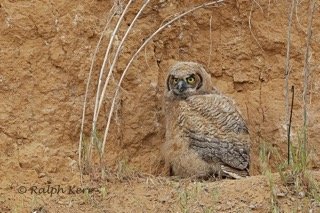Walla Walla, WA Field Trip Report
Great-Horned Owl Owlet by Ralph Kerr
Submitted by Ted Smith, Coeur d’Alene Audubon Chapter President
April 27-28, 2024
Eleven Coeur d’Alene Audubon members gathered in Dayton, Washington for the field trip to Walla Walla last weekend. We visited Bennington Lake, a site that was recommended to us by Blue Mountain Audubon. Before we even finished parking, we saw a great-horned owl owlet on a bank next to the parking lot. He was drawing quite a bit of attention and later in the morning we found his two siblings sharing a nest hole in the bank. We heard numerous yellow and yellow-rumped warblers and Ralph found a great-horned owl nest that had three owlets in it (we got an assist there from a Blue Mountain Audubon member and his wife that we met along the way).
We visited the aviary at Pioneer Park in Walla Walla. They have a very nice aviary that was really fun to visit.
On Sunday we checked out and headed for Whitman Mission National Historical Park. We met Mike Denny there. You might remember him as the narrator / star of the two desert ecology videos we have had as programs at past meetings. Mike led us around the mission grounds on trails and pointed out vegetation and birds along the way. He has a great breadth of knowledge on not only local ecology and geology but history as well. We didn’t see great numbers of species (13) but as happened the day before we didn’t have the weather in our favor. Highlights were several Swainson’s hawks and a Lewis’s woodpecker.
Our next stop took us to the Wallula Junction area where we birded at a site called the “millet fields”. It was obvious that when the water is in there this would be an amazing birding site. Unfortunately most of the wetlands that were wet were a long walk from where we could park. Some spotting scope work did turn up a great egret and some white pelicans as well as northern harrier, Swainson’s hawk, and red-tailed hawk.
Our next stop was at McNary National Wildlife Refuge. The wind was blowing pretty hard and most of the waterfowl species had already migrated out of the area. It was worth the stop though, as we saw Caspian terns, snow geese, a black-necked stilt and a very large flock of northern shovelers.
All in all it was a great trip with wonderful people. My final species count was 58 bird species, so all in all not a bad outing. At least form my perspective a great time was had by all.

